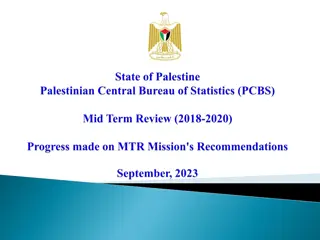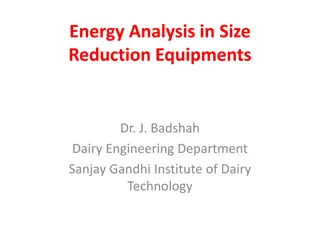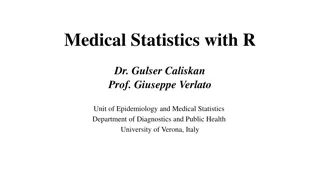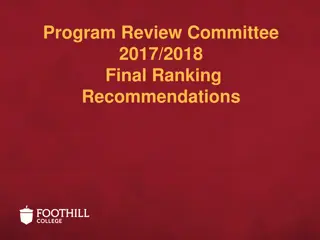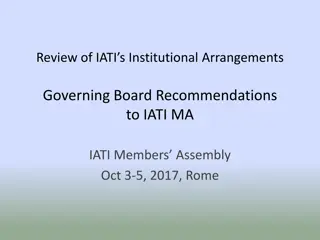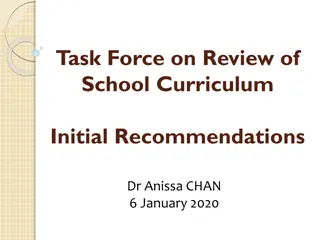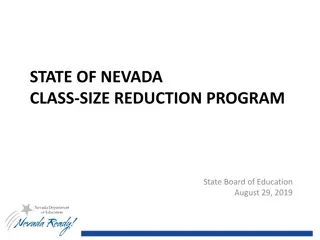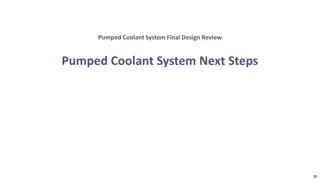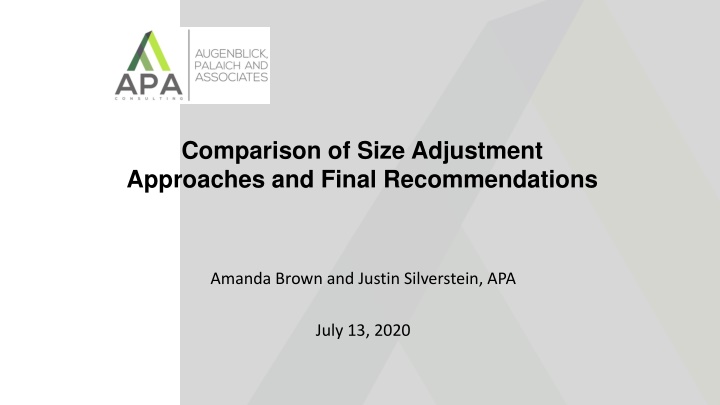
Approaches and Recommendations for Size Adjustment in Education Districts
Explore the comparison of size adjustment approaches in education districts and discover final recommendations based on enrollment, attendance, area, and more. Review the different adjustments addressing district characteristics and understand how transportation funding varies. Gain insights into the intended adjustments for small schools and district needs.
Download Presentation

Please find below an Image/Link to download the presentation.
The content on the website is provided AS IS for your information and personal use only. It may not be sold, licensed, or shared on other websites without obtaining consent from the author. If you encounter any issues during the download, it is possible that the publisher has removed the file from their server.
You are allowed to download the files provided on this website for personal or commercial use, subject to the condition that they are used lawfully. All files are the property of their respective owners.
The content on the website is provided AS IS for your information and personal use only. It may not be sold, licensed, or shared on other websites without obtaining consent from the author.
E N D
Presentation Transcript
Comparison of Size Adjustment Approaches and Final Recommendations Amanda Brown and Justin Silverstein, APA July 13, 2020
Todays Presentation Brief review of prior presentations Review of all size adjustment approaches Overview of additional analysis Review of enrollment, attendance area, square mileage, density data for all districts Review of current school level expenditure and staffing information from four selected districts: Carson City, Elko, Lincoln, Nye Examination of different size adjustment approaches in selected districts Final recommendations 2
Prior Meeting Recap: District Characteristic Adjustments There are four types of formula adjustments intended to address the differing costs of education associated with schools and districts: District size adjustments Necessarily small schools (or geographically isolated schools) adjustments District density adjustments Regional cost adjustments States often have separate transportation funding approaches to recognize how transportation costs vary between districts Often, these adjustments are addressing a similar set of district characteristic needs in different ways Size/economies of scale, salary and goods costs, remoteness, and transportation 4
Prior Meeting Recap: Overlapping District Characteristic Adjustments District Size - Economies of Scale (school and district-level) - Remoteness - Cost of goods Necessarily Small Schools - Economies of scale, school-level - Remoteness Regional Cost - Salaries - Cost of goods Density - Economies of scale (school and district-level) - Remoteness - Costs of transportation Transportation - Costs of transportation - Remoteness 5
Prior Meeting Recap: How PCFP Adjustments are Intended to Address District Needs Necessarily small schools Separate Transportation Funding Issues Intended to Address District Size NCEI Small, remote schools x Economies of scale - School-level x x - District-level x Transportation costs x Costs of goods x x x Salary costs x 6
Prior Meeting Recap: Conclusions PCFP adjustments address many of the cost pressures districts face APA did not recommend a separate adjustment for density, but did recommend continuing to explore applying the district size adjustment by attendance area Initial data review suggested approach increased funding for larger square mileage districts operating more remote attendance areas, but further data analysis was needed to confirm that this approach was reflective of need Committee and NDE requested that APA specifically look at the impact of funding approaches in select districts Questions to be addressed: is there a fundamental disconnect in how we have addressed schools and districts in the Nevada Plan vs. PCFP that has led to very different funding? Is this reflective of actual cost differences? 7
Review of Approaches to Address District Size/Density 8
Nevada Plans Approach Basic Support Ratio (District Groupings) approach that addressed differences in costs at the attendance area level (for teacher allocations) and then district level based upon prior expenses and comparing districts against others in groupings BSRs change for districts each biennium based upon relative differences Can cause large fluctuations in BSR values over time 9
Current PCFP Approach District Size Adjustment + Tiered Necessarily Small Schools Adjustment Primarily addresses differences in cost at the district level using a size adjustment formula applied to district enrollment Formula developed through APA s adequacy work Additional tiered adjustment for necessarily small schools with less than 150 students Size adjustment that a district would receive only changes in relationship to changes in enrollment 10
Current PCFP Approach: District Size Adjustment Applies a size adjustment formula to district enrollment (with a floor of 1.0): For districts above 3,900 students: Size adjustment factor = (-.000001735*enrollment) + 1.0868 For districts below 3900 students: Size adjustment factor = (-0.281*ln(enrollment)) + 3.4 The results of this formula are shown as factors in the table below: District Enrollment 50 100 250 500 1,000 2,500 5,000 10,000 25,000 50,000 and above Size Adjustment Factor 2.30 2.11 1.85 1.65 1.46 1.20 1.08 1.06 1.04 1.00 11
Current PCFP Approach: Necessarily Small Schools (NSS) Adjustment Generates additional funding for necessarily small schools of less than 150 students, tiered based upon their enrollment: Less than 7 students, minimum of 1 teacher and 1 assistant principal Between 7-49 students, 1 teacher per 7 students and 1 assistant principal Between 50-74 students, 1 teacher per 9 students and 1 assistant principal Between 75-99 students, 1 teacher per 11 students and 1 assistant principal Between 100-124 students, 1 teacher per 13 students and 1 assistant principal Between 125-149 students, 1 teacher per 15 students and 1 assistant principal Additional per student funding is net a given district s size adjusted base funding amount 12
AIRs Approach AIR (2012) disaggregated scale from wage-based adjustments in the Nevada Plan s BSR (District Groupings) approach, referred to as the DSA Scale Only Adjustment (representing differences due to both size and density) APA has used this DSA Scale Only adjustment as a comparison throughout its work with the Commission AIR recommended using an alternative scale adjustment instead of the DSA Scale Only in the Nevada Plan Modeled a number of approaches based upon other states, including highlighting New York s model for addressing size and density as an option No adjustment for central/dense or large districts Lower adjustments than DSA Scale Only in smallest districts 13
Attendance Area Approach Apply the same district size adjustment formula developed by APA, but instead apply it to each attendance area s enrollment independently Attendance areas, as identified in the prior Nevada Plan funding model, were developed based on city centers, or towns that are geographically isolated Results in districts with multiple attendance areas receiving a higher size adjustment factor; largest impacts in large square mileage districts Apply NSS adjustment (net) 14
Attendance Area Approach: Example Example district of 4,000 students with 4 attendance areas of different sizes: District Size Approach Attendance Area Size Approach Enrollment Attendance Area A Attendance Area B Attendance Area C Attendance Area D District Total 2,000 1,000 500 500 4,000 - - - - 1.26 1.46 1.65 1.65 1.41 1.08 Under the current district size approach in the PCFP, the district would receive a size factor of 1.08 Applying the same formula to attendance area size instead would result in a combined size adjustment of 1.41 In both scenarios, NSS funding would be net 15
Approach Comparison Chart Approach Comparison 3.50 3.00 2.50 2.00 1.50 1.00 -1,000 1,000 3,000 5,000 7,000 9,000 11,000 13,000 15,000 District Size + NSS Attendance Area Size + NSS FY20 DSA Scale Only AIR Recommendation District Size + NSS adjustment and AIR's recommendation are somewhat similar, though the APA adjustment is higher at both ends Attendance Area Size + NSS adjustment and DSA Scale Only are more aligned 16
Additional Analysis Reviewed density, size, and attendance center data on all districts Examined current school level expenditures and staffing for the four selected districts (Carson City, Elko, Lincoln, Nye) Districts represent a rage of district experiences in terms of density, square mileage, size and number of attendance centers Compared current expenditures in these districts to the different approaches for addressing size: Nevada Plan (FY20 BSR Scale Only) District Size + Necessarily Small Schools Attendance Center Size + Necessarily Small Schools (district size formula applied to attendance area size) 18
Review of District Data Students per Sq Mile Number of Attendance Areas District 2019 WADA Sq Miles Carson City Churchill Clark Douglas Elko Esmeralda Eureka Humboldt Lander Lincoln Lyon Mineral Nye Pershing Storey Washoe White Pine Average 7,646 3,202 319,310 5,748 9,702 145 4,931 7,892 710 17,169 3,582 4,176 9,641 5,490 10,633 2,001 3,753 18,182 6,037 264 6,301 8,875 6,458 52.7 0.6 40.5 8.1 0.6 0.0 0.1 0.4 0.2 0.1 4.3 0.1 0.3 0.1 1.6 10.1 0.1 7.1 1 1 11 3 11 3 2 6 2 4 5 2 7 2 2 8 4 4 70 268 3,427 988 960 8,541 539 5,153 668 429 63,495 1,212 25,374 19
Map of Attendance Areas and District Boundaries https://www.google.com/maps/d/viewer?mid=1siQCO8 tJL9CFhLW7YNXkY05xlQsxfDax&usp=sharing 20
Approach Comparison Table District Size + NSS Attendance Area Size + NSS FY20 DSA Scale Only AIR Alternative (NY) District Carson City Churchill Clark Douglas Elko Esmeralda Eureka Humboldt Lander Lincoln Lyon Mineral Nye Pershing Storey Washoe White Pine 1.08 1.14 1.00 1.09 1.12 2.60 1.86 1.19 1.49 1.49 1.07 1.69 1.16 1.61 1.73 1.00 1.52 1.08 1.14 1.01 1.14 1.24 2.70 1.94 1.22 1.49 1.83 1.23 1.77 1.27 1.61 1.78 1.03 1.63 1.17 1.19 1.00 1.21 1.29 3.13 2.67 1.32 1.42 1.91 1.20 1.68 1.33 1.63 1.71 1.03 1.48 1.00 1.20 1.00 1.00 1.00 3.15 2.69 1.33 1.43 1.92 1.00 1.69 1.00 1.64 1.72 1.00 1.49 21
School Staffing in Select Districts Teacher to Student Ratio by School Type Includes all licensed teachers Elementary Secondary K-12 40.0 40.0 40.0 35.0 35.0 35.0 30.0 30.0 30.0 25.0 25.0 25.0 20.0 20.0 20.0 15.0 15.0 15.0 10.0 10.0 10.0 5.0 5.0 5.0 - - - - 200.0 400.0 600.0 800.0 1,000.0 - 500.0 1,000.0 1,500.0 2,000.0 2,500.0 - 100.0 200.0 300.0 400.0 Appears to be based on ratios rather than size across all school types No discernable pattern by remoteness of location 22
School Staffing in Select Districts: Administrator to Student Ratio by School Type Includes principals, assistant principals, and deans Elementary K-12 Secondary 500.0 500.0 500.0 450.0 450.0 450.0 400.0 400.0 400.0 350.0 350.0 350.0 300.0 300.0 300.0 250.0 250.0 250.0 200.0 200.0 200.0 150.0 150.0 150.0 100.0 100.0 100.0 50.0 50.0 50.0 - - - - 200.0 400.0 600.0 800.0 1,000.0 - 100.0 200.0 300.0 400.0 - 500.0 1,000.0 1,500.0 2,000.0 2,500.0 Administrator ratios are related to school size across all school types (economies of scale) 23
School Staffing in Select Districts: Office Personnel to Student Ratio by School Type Includes secretary, admin assistants and payroll clerks Elementary Secondary K-12 500.0 500.0 500.0 450.0 450.0 450.0 400.0 400.0 400.0 350.0 350.0 350.0 300.0 300.0 300.0 250.0 250.0 250.0 200.0 200.0 200.0 150.0 150.0 150.0 100.0 100.0 100.0 50.0 50.0 50.0 - - - - 200.0 400.0 600.0 800.0 1,000.0 - 500.0 1,000.0 1,500.0 2,000.0 2,500.0 - 50.0 100.0 150.0 200.0 250.0 300.0 350.0 400.0 Office staffing ratios in elementary schools are related to size (economies of scale) Slightly related to size in secondary level schools Based off ratios in K-12 level schools 24
School Staffing in Select Districts: Support Personnel to Student Ratio by School Type Includes professional staff such as nurses, counselors, social workers, and librarians K-12 Elementary Secondary 700.0 700.0 700.0 600.0 600.0 600.0 500.0 500.0 500.0 400.0 400.0 400.0 300.0 300.0 300.0 200.0 200.0 200.0 100.0 100.0 100.0 - - - - 200.0 400.0 600.0 800.0 1,000.0 - 500.0 1,000.0 1,500.0 2,000.0 2,500.0 - 100.0 200.0 300.0 400.0 Not related to size or based upon specific ratios and does not appear to be related to school location Decisions subjective to the district 25
School Level Expenditures in Select Districts Current School Expenditures in Select Districts 3.50 3.00 2.50 2.00 1.50 1.00 0.50 - 0 500 1,000 1,500 2,000 2,500 Expenditures are in part based upon size and how remote the school is, but also represent different district decisions/ available revenues 26
Attendance Level Expenditures in Select Districts: Comparison to Nevada Plan Comparsion of Current Expenditures to DSA Scale Only 7.00 6.00 5.00 4.00 3.00 2.00 1.00 0.00 0 1000 2000 3000 4000 5000 6000 7000 8000 9000 Current DSA Scale Only Expenditures at the attendance area level are fairly related to DSA Scale Only, but are not as high in some circumstances 27
Attendance Level Expenditures in Select Districts: Comparison to APA Approaches Comparsion of Current Expenditures to APA Approaches 5.00 4.50 4.00 3.50 3.00 2.50 2.00 1.50 1.00 0.50 0.00 0 1000 2000 3000 4000 5000 6000 7000 8000 District Size + NSS Attendance + NSS Current Funding at the attendance area level is more representative of current expenditures, though both are higher for the smallest settings 28
APA Recommends Applying the District Size Adjustment at the Attendance Area Level Rationale Applying the adjustment at the attendance area level better reflects the cost districts face for having to operate multiple remote settings The number of attendance areas better predicts the cost differential compared to density Size of attendance centers is aligned with the size of schools Therefore, addressing attendance center size addresses school size as well Attendance centers are similar to having districts within districts Nevada has the fewest districts compared to any other state other than Hawaii and DC; other western states serving multiple remote populations centers often have separate districts 30
APA Recommends Using a Single Formula (Combining Attendance Area Size Adjustment + NSS) Uses the same curve (formula) as the district size adjustment, but increases the scale of the adjustment for the smallest attendance areas Adjusts the tail of the J-curve to be steeper in the smallest settings Rationale Allows for a single formula to be used instead of two separate adjustments Easier to apply and more transparent Did not see district s current spending at the scale of the NSS, so combined adjustment will be slightly lower than NSS The bill requires that NSS funding be sent directly to the school which might overfund these settings Funding through the district size adjustment goes to the district to be distributed at their discretion 31
Single Formula Comparison Chart Single Formula vs. Two Separate Adjustments Comparison 3.00 2.80 2.60 2.40 2.20 2.00 1.80 1.60 1.40 1.20 1.00 -1,000 1,000 3,000 5,000 7,000 9,000 11,000 13,000 15,000 Attendance Area Size + NSS Combined Attendance Area Formula Minimal variation at district level between two separate adjustments and single formula 32
Comparison of Current PCFP Adjustments and Recommendations District Size + NSS, Factor Single Attendance Area Formula, Factor Single Attendance Area Formula, Funding Generated $3,466,062 $2,679,491 $20,454,217 $4,758,682 $14,555,032 District Size + NSS, Funding Generated $3,891,655 $2,869,376 $1,738,198 $3,405,739 $7,609,921 Percent % District Carson City Churchill Clark Douglas Elko Esmeralda Eureka Humboldt Lander Lincoln Lyon Mineral Nye Pershing Storey Washoe White Pine Total 1.08 1.14 1.00 1.09 1.12 2.60 1.86 1.19 1.49 1.49 1.07 1.69 1.16 1.61 1.73 1.00 1.52 1.07 1.13 1.01 1.13 1.23 2.74 1.94 1.21 1.49 1.83 1.23 1.73 1.24 1.61 1.78 1.03 1.59 -1% -1% 1% 3% 10% 6% 4% 1% 0% 22% 14% 3% 6% 0% 3% 3% 5% $837,738 $1,638,176 $4,190,308 $3,037,975 $2,884,364 $4,210,477 $2,364,720 $5,554,191 $2,550,510 $2,118,131 220021.62 $5,274,319 $54,395,820 $913,619 $1,794,139 $4,578,679 $3,050,494 $4,841,113 $13,023,001 $2,511,592 $8,099,640 $2,563,612 $2,269,768 $12,232,706 $5,973,698 $107,765,546 - - - 33
Impact of Final Recommendations Compared to Current PCFP Adjustments Impact to districts from of moving to Single Attendance Area Adjustment compared from District Size Adjustment + NSS Change of -1% to 22% Larger square mileage districts and districts with more attendance areas received higher changes in funding as a result Minimal variation for about half of districts Following figures are estimated and could vary based upon attendance area definitions and updated enrollment counts 34
Commission Considerations To adopt APA recommendations, Committee will need to recommend: Calculating the current Small District Equity Adjustment at the attendance area level Modifying the size adjustment formula used to the following: For districts above 3,900 students: Size adjustment factor = (-.000001735*enrollment) + 1.0868 For districts below 3900 students: Size adjustment factor = (-0.281*ln(enrollment)) + 3.4 For districts below 18 students: Size adjustment factor = 25.003*(enrollment^-0.791) Removing the Necessarily Small Schools adjustment as redundant 35
Questions? 36

